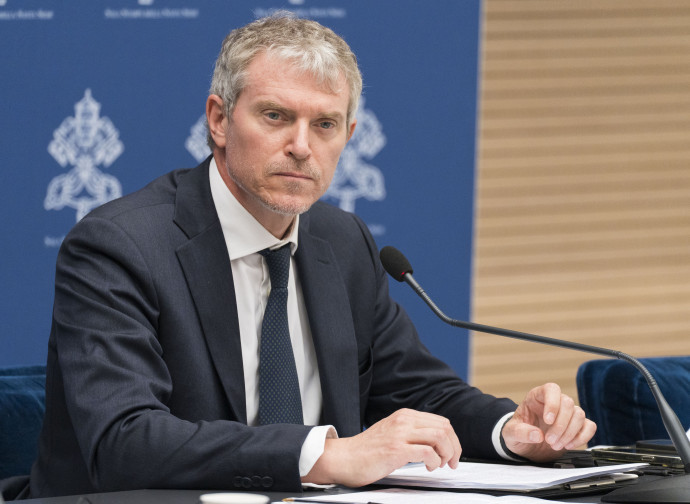The uncomfortable question about the Latin Mass sends Bruni into a tailspin
With documents in hand, Diane Montagna reveals that the majority of bishops did not ask for restrictions on the ancient rite, as Pope Francis wrote. The director of the Press Office neither confirms nor denies this, but falters. And he does not allow the secretary of Divine Worship to respond.

In 2021, Francis said he wanted to repeal the liberalisation of the so-called Tridentine Mass on the basis of a consultation of bishops carried out by the Congregation for the Doctrine of the Faith a year earlier, which would have sent to Rome responses revealing a situation that – wrote Bergoglio – ‘saddens and worries me, confirming my need to intervene’ because ‘the opportunity offered by St. John Paul II and with even greater magnanimity by Benedict XVI (...) has been used to increase distances, harden differences, and build oppositions that wound the Church and slow her progress, exposing her to the risk of divisions.’
Four years later, an American journalist, Diane Montagna, revealed that this was not true: the majority of the bishops consulted who had applied the motu proprio Summorum Pontificum had declared themselves satisfied and had even warned the former Holy Office of the risks of a possible restriction. This sensational truth was put in black and white by the Congregation for the Doctrine of the Faith in a report that was delivered to Francis and presented a very different picture of the situation from that reported in Traditionis Custodes and in the accompanying letter to the bishops.
Montagna's is a Vatican Watergate and, documents in hand, indicates that the late Pope lied to justify his decision to limit celebrations in extraordinary form, attributing the will to the episcopate and the current Congregation for the Doctrine of the Faith.
This reversal of the majority will shatters the image of a pontificate centred on proclamations of synodality and collegiality. But let us be clear: Francis could repeal Summorum Pontificum despite the opinion of the bishops because, as Ratzinger argued, the Church is not a democracy.
Faced with such a “bomb”, which inevitably exploded around the world and provoked hundreds of thousands of reactions, how did the Holy See respond? Yesterday, a press conference was held in the Press Office to present the new formula for the Missa “pro custodia creationis”. Among the speakers was Monsignor Vittorio Francesco Viola, secretary of the Dicastery for Divine Worship and the Discipline of the Sacraments and therefore one of the highest executors of Traditionis Custodes, given that the motu proprio entrusted his dicastery with the observance of the provisions. It was therefore inevitable that, finding herself face to face with Monsignor Viola, a journalist (Hannah Brockhaus of CNA) would feel the need to ask him a question about Montagna's scoop and to seek clarification. At that point, however, the director of the Press Office, Matteo Bruni, took the floor to rebuke the journalist, saying, ‘I don't think that's a relevant question.’
Perhaps Bruni forgets that it is not his job to judge journalists' questions. Although he does not have a background in journalism, the director should know that information professionals always give priority to the news: it is entirely natural to put the topic of a conference in the background when faced with an interlocutor who is directly interested in such a disruptive issue on which there have been no official statements.
Bruni started badly, but ended his speech even worse. Clearly anticipating that the “irrelevant” question would come (all the more so if he was expecting it, was that paternalistic remark about irrelevance really necessary?), he had a sheet of paper in front of him from which he read with some hesitation. “I do not confirm the authenticity of the texts,” said the director of the Press Office, “which have been published and presumably concern part of one of the documents on which the decision was based, and as such fuel a very partial and incomplete reconstruction of the decision-making process”.
So Bruni “does not confirm”, which in Italian means that he does not deny it either. Then, again, he makes an unsolicited judgement on the reconstruction that has become public, four years later, thanks to the meticulous and unassailable work of Diane Montagna. ‘The consultation mentioned above was subsequently supplemented by other documentation, other confidential reports, including the result of further consultations received by the Congregation for the Doctrine of the Faith.’
And here it would be legitimate to ask what the ‘other documentation’ brought up by the director of the Press Office might be, since Francis in Traditionis Custodes spoke neither of confidential reports nor of further consultations, but only of the ‘extensive consultation of bishops in 2020’ and the ‘opinion of the Congregation for the Doctrine of the Faith.’ Both, as we have discovered thanks to Montagna, are opposed to the restrictions. Clearly, Bruni's vague ‘non-confirmation’ leaves things as they are, and now, three days after the publication of the scoop, everyone accepts what the director has called a ‘very partial and incomplete reconstruction of the decision-making process.’
The Holy See's embarrassment in the face of a revelation that is uncomfortable for the memory of a pontiff is understandable, but one cannot think of handling such news, which has circulated around the world, as if it were an annoying unexpected event to be dismissed in a few seconds with convoluted formulas (‘I do not confirm’) and throwing in new and vague elements never mentioned before (‘confidential reports’). After a twelve-year truce, the media war against the papacy seen during the years of Benedict XVI could resume with a Pope as popular among Catholics as Leo XIV. Is this how Vatican communications thinks it can protect Prevost from possible crises and attacks from the media, which is traditionally hostile to the Church, with a few lines of text read distractedly?




